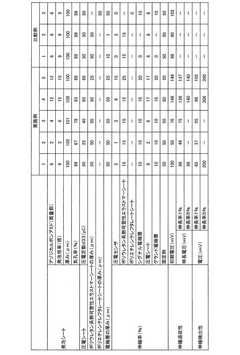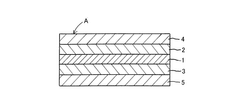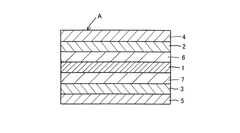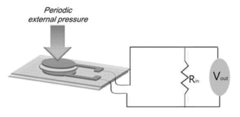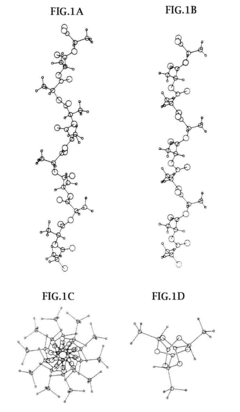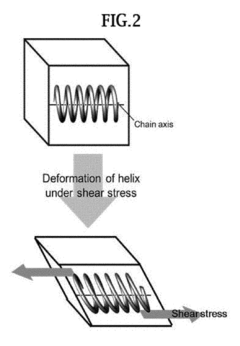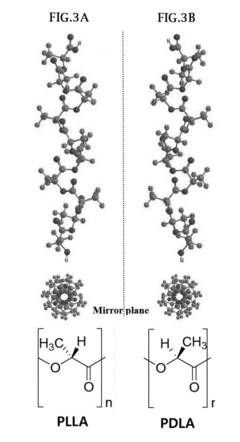What PU‑Based Piezoelectric Films Drive Wearable Sensors?
JUN 25, 20259 MIN READ
Generate Your Research Report Instantly with AI Agent
Patsnap Eureka helps you evaluate technical feasibility & market potential.
PU-Based Piezo Films: Background and Objectives
Polyurethane-based (PU-based) piezoelectric films have emerged as a promising technology in the field of wearable sensors, offering a unique combination of flexibility, durability, and electrical responsiveness. The development of these films represents a significant advancement in materials science, bridging the gap between traditional rigid piezoelectric materials and the demands of modern wearable technology.
The evolution of PU-based piezoelectric films can be traced back to the early 2000s when researchers began exploring the potential of incorporating piezoelectric properties into flexible polymers. This innovation was driven by the growing need for sensors that could conform to the human body while maintaining high sensitivity to mechanical stimuli. The goal was to create materials that could effectively transduce physical movements and pressures into electrical signals, enabling a wide range of applications in health monitoring, sports performance analysis, and human-machine interfaces.
As the field progressed, several key objectives emerged. Foremost among these was the enhancement of the piezoelectric response in PU-based films. Researchers aimed to achieve higher voltage outputs and improved sensitivity to subtle movements and pressures. This involved experimenting with various dopants and nanoparticles to optimize the film's piezoelectric properties while maintaining its essential flexibility and biocompatibility.
Another critical objective in the development of PU-based piezoelectric films was to improve their long-term stability and reliability. Wearable sensors are subjected to repeated deformation, environmental stresses, and varying temperatures, necessitating materials that can maintain their performance over extended periods. This led to investigations into different PU formulations and protective coatings to enhance the durability of the films without compromising their piezoelectric properties.
The miniaturization of sensors and the integration of PU-based piezoelectric films into complex wearable systems became increasingly important objectives. This involved developing fabrication techniques that allowed for the production of ultra-thin films and exploring methods to incorporate these films into textiles and other wearable substrates seamlessly. The goal was to create unobtrusive sensors that could be comfortably worn for extended periods without interfering with the user's daily activities.
As the potential applications for PU-based piezoelectric films in wearable sensors expanded, researchers also focused on enhancing their biocompatibility and addressing potential safety concerns. This included studies on the long-term effects of these materials on skin health and investigations into hypoallergenic formulations to ensure widespread usability across diverse populations.
The ongoing development of PU-based piezoelectric films for wearable sensors continues to be driven by the vision of creating highly sensitive, flexible, and durable materials that can seamlessly integrate with the human body. As technology advances, these films are expected to play a crucial role in the next generation of wearable devices, enabling more sophisticated health monitoring, enhanced human-computer interaction, and innovative applications in fields ranging from medicine to sports and beyond.
The evolution of PU-based piezoelectric films can be traced back to the early 2000s when researchers began exploring the potential of incorporating piezoelectric properties into flexible polymers. This innovation was driven by the growing need for sensors that could conform to the human body while maintaining high sensitivity to mechanical stimuli. The goal was to create materials that could effectively transduce physical movements and pressures into electrical signals, enabling a wide range of applications in health monitoring, sports performance analysis, and human-machine interfaces.
As the field progressed, several key objectives emerged. Foremost among these was the enhancement of the piezoelectric response in PU-based films. Researchers aimed to achieve higher voltage outputs and improved sensitivity to subtle movements and pressures. This involved experimenting with various dopants and nanoparticles to optimize the film's piezoelectric properties while maintaining its essential flexibility and biocompatibility.
Another critical objective in the development of PU-based piezoelectric films was to improve their long-term stability and reliability. Wearable sensors are subjected to repeated deformation, environmental stresses, and varying temperatures, necessitating materials that can maintain their performance over extended periods. This led to investigations into different PU formulations and protective coatings to enhance the durability of the films without compromising their piezoelectric properties.
The miniaturization of sensors and the integration of PU-based piezoelectric films into complex wearable systems became increasingly important objectives. This involved developing fabrication techniques that allowed for the production of ultra-thin films and exploring methods to incorporate these films into textiles and other wearable substrates seamlessly. The goal was to create unobtrusive sensors that could be comfortably worn for extended periods without interfering with the user's daily activities.
As the potential applications for PU-based piezoelectric films in wearable sensors expanded, researchers also focused on enhancing their biocompatibility and addressing potential safety concerns. This included studies on the long-term effects of these materials on skin health and investigations into hypoallergenic formulations to ensure widespread usability across diverse populations.
The ongoing development of PU-based piezoelectric films for wearable sensors continues to be driven by the vision of creating highly sensitive, flexible, and durable materials that can seamlessly integrate with the human body. As technology advances, these films are expected to play a crucial role in the next generation of wearable devices, enabling more sophisticated health monitoring, enhanced human-computer interaction, and innovative applications in fields ranging from medicine to sports and beyond.
Market Analysis for Wearable Sensor Applications
The wearable sensor market has experienced significant growth in recent years, driven by increasing consumer awareness of health monitoring and the growing adoption of IoT technologies. PU-based piezoelectric films have emerged as a key enabling technology for wearable sensors, offering unique advantages in flexibility, sensitivity, and durability.
The global wearable sensor market is projected to reach substantial value in the coming years, with a compound annual growth rate (CAGR) outpacing many other technology sectors. This growth is fueled by the rising demand for continuous health monitoring, fitness tracking, and the integration of sensors in smart clothing and accessories.
Within the wearable sensor ecosystem, PU-based piezoelectric films are finding applications across various segments. The healthcare sector represents a major market opportunity, with these films being used in devices for monitoring vital signs, detecting body movements, and even in advanced medical applications such as gait analysis and fall detection for elderly care.
The sports and fitness industry is another significant market for PU-based piezoelectric film sensors. These sensors are being incorporated into athletic wear, shoes, and accessories to provide real-time performance data, biomechanical analysis, and injury prevention insights. The ability of these films to capture subtle movements and pressures makes them ideal for high-precision sports analytics.
Consumer electronics represent a rapidly expanding market for wearable sensors utilizing PU-based piezoelectric films. Smartwatches, fitness bands, and other wearable devices are increasingly incorporating these sensors for gesture recognition, touch-sensitive interfaces, and haptic feedback systems.
The industrial sector is also showing interest in wearable sensors with PU-based piezoelectric films for applications in worker safety, ergonomics monitoring, and human-machine interfaces. These sensors can be integrated into protective equipment and work uniforms to monitor environmental conditions and worker movements.
Market trends indicate a growing preference for miniaturization and integration of multiple sensing capabilities in a single device. PU-based piezoelectric films are well-positioned to meet these demands due to their thin profile and versatility. Additionally, there is an increasing focus on developing self-powered wearable sensors, where the piezoelectric properties of these films can be harnessed for energy harvesting.
Geographically, North America and Europe currently lead the market for wearable sensors, including those based on PU piezoelectric films. However, the Asia-Pacific region is expected to show the highest growth rate in the coming years, driven by rapid technological adoption and increasing healthcare expenditure.
The global wearable sensor market is projected to reach substantial value in the coming years, with a compound annual growth rate (CAGR) outpacing many other technology sectors. This growth is fueled by the rising demand for continuous health monitoring, fitness tracking, and the integration of sensors in smart clothing and accessories.
Within the wearable sensor ecosystem, PU-based piezoelectric films are finding applications across various segments. The healthcare sector represents a major market opportunity, with these films being used in devices for monitoring vital signs, detecting body movements, and even in advanced medical applications such as gait analysis and fall detection for elderly care.
The sports and fitness industry is another significant market for PU-based piezoelectric film sensors. These sensors are being incorporated into athletic wear, shoes, and accessories to provide real-time performance data, biomechanical analysis, and injury prevention insights. The ability of these films to capture subtle movements and pressures makes them ideal for high-precision sports analytics.
Consumer electronics represent a rapidly expanding market for wearable sensors utilizing PU-based piezoelectric films. Smartwatches, fitness bands, and other wearable devices are increasingly incorporating these sensors for gesture recognition, touch-sensitive interfaces, and haptic feedback systems.
The industrial sector is also showing interest in wearable sensors with PU-based piezoelectric films for applications in worker safety, ergonomics monitoring, and human-machine interfaces. These sensors can be integrated into protective equipment and work uniforms to monitor environmental conditions and worker movements.
Market trends indicate a growing preference for miniaturization and integration of multiple sensing capabilities in a single device. PU-based piezoelectric films are well-positioned to meet these demands due to their thin profile and versatility. Additionally, there is an increasing focus on developing self-powered wearable sensors, where the piezoelectric properties of these films can be harnessed for energy harvesting.
Geographically, North America and Europe currently lead the market for wearable sensors, including those based on PU piezoelectric films. However, the Asia-Pacific region is expected to show the highest growth rate in the coming years, driven by rapid technological adoption and increasing healthcare expenditure.
Current Challenges in PU-Based Piezoelectric Films
Despite the promising potential of PU-based piezoelectric films in wearable sensors, several challenges hinder their widespread adoption and optimal performance. One of the primary obstacles is the relatively low piezoelectric coefficient of PU-based materials compared to traditional ceramic piezoelectrics. This limitation affects the sensitivity and overall efficiency of the sensors, potentially restricting their application in scenarios requiring high precision measurements.
Another significant challenge lies in the long-term stability and durability of PU-based piezoelectric films. When subjected to repeated mechanical stress and environmental factors such as temperature fluctuations and humidity, these films may experience degradation in their piezoelectric properties over time. This degradation can lead to inconsistent sensor readings and reduced reliability, which is particularly problematic for wearable devices intended for continuous, long-term use.
The integration of PU-based piezoelectric films into flexible and stretchable substrates presents additional technical hurdles. Achieving seamless integration while maintaining the film's piezoelectric properties and ensuring proper electrical connections remains a complex task. The interface between the piezoelectric film and the substrate must be carefully engineered to prevent delamination and maintain consistent performance under various deformation conditions.
Furthermore, the manufacturing scalability of high-quality PU-based piezoelectric films poses a significant challenge. Current production methods often struggle to achieve uniform film thickness and consistent piezoelectric properties across large areas, which is crucial for mass production and commercialization of wearable sensors. The development of cost-effective, large-scale manufacturing processes that maintain the desired film characteristics is an ongoing area of research.
Another challenge lies in the optimization of the film's composition and structure to enhance its piezoelectric response. While various approaches, such as incorporating nanoparticles or creating specific polymer blends, have shown promise, finding the ideal balance between improved piezoelectric properties and maintaining the film's flexibility and biocompatibility remains a complex task.
Lastly, the development of standardized testing and characterization methods for PU-based piezoelectric films in wearable sensor applications is an ongoing challenge. The lack of universally accepted protocols for evaluating the performance and reliability of these films in real-world conditions hinders their widespread adoption and makes it difficult to compare different materials and designs effectively.
Another significant challenge lies in the long-term stability and durability of PU-based piezoelectric films. When subjected to repeated mechanical stress and environmental factors such as temperature fluctuations and humidity, these films may experience degradation in their piezoelectric properties over time. This degradation can lead to inconsistent sensor readings and reduced reliability, which is particularly problematic for wearable devices intended for continuous, long-term use.
The integration of PU-based piezoelectric films into flexible and stretchable substrates presents additional technical hurdles. Achieving seamless integration while maintaining the film's piezoelectric properties and ensuring proper electrical connections remains a complex task. The interface between the piezoelectric film and the substrate must be carefully engineered to prevent delamination and maintain consistent performance under various deformation conditions.
Furthermore, the manufacturing scalability of high-quality PU-based piezoelectric films poses a significant challenge. Current production methods often struggle to achieve uniform film thickness and consistent piezoelectric properties across large areas, which is crucial for mass production and commercialization of wearable sensors. The development of cost-effective, large-scale manufacturing processes that maintain the desired film characteristics is an ongoing area of research.
Another challenge lies in the optimization of the film's composition and structure to enhance its piezoelectric response. While various approaches, such as incorporating nanoparticles or creating specific polymer blends, have shown promise, finding the ideal balance between improved piezoelectric properties and maintaining the film's flexibility and biocompatibility remains a complex task.
Lastly, the development of standardized testing and characterization methods for PU-based piezoelectric films in wearable sensor applications is an ongoing challenge. The lack of universally accepted protocols for evaluating the performance and reliability of these films in real-world conditions hinders their widespread adoption and makes it difficult to compare different materials and designs effectively.
Existing PU-Based Piezoelectric Film Solutions
01 Composition and structure of PU-based piezoelectric films
PU-based piezoelectric films are composed of polyurethane matrices with embedded piezoelectric materials. The structure and composition of these films can be optimized to enhance their piezoelectric properties. Various additives and processing techniques can be employed to improve the film's performance and durability.- Composition and structure of PU-based piezoelectric films: PU-based piezoelectric films are composed of polyurethane matrices with embedded piezoelectric materials. These films can be fabricated in various structures, including single-layer, multi-layer, or composite configurations. The composition and structure of the films significantly influence their piezoelectric properties and performance in different applications.
- Fabrication methods for PU-based piezoelectric films: Various fabrication techniques are employed to produce PU-based piezoelectric films, including solution casting, electrospinning, and 3D printing. These methods allow for precise control over film thickness, porosity, and piezoelectric material distribution within the polyurethane matrix, enabling tailored properties for specific applications.
- Applications of PU-based piezoelectric films: PU-based piezoelectric films find applications in diverse fields such as energy harvesting, sensors, actuators, and wearable electronics. Their flexibility, durability, and tunable properties make them suitable for integration into various devices and systems, including medical implants, structural health monitoring, and smart textiles.
- Enhancement of piezoelectric properties in PU-based films: Researchers have developed methods to enhance the piezoelectric properties of PU-based films, including the incorporation of nanofillers, optimization of poling conditions, and surface modification techniques. These enhancements aim to improve the sensitivity, output voltage, and overall performance of the piezoelectric films for various applications.
- Characterization and testing of PU-based piezoelectric films: Various characterization and testing methods are employed to evaluate the performance and properties of PU-based piezoelectric films. These include electrical characterization, mechanical testing, and piezoelectric response measurements under different conditions. Advanced imaging techniques and computational modeling are also used to analyze the film structure and predict performance.
02 Applications of PU-based piezoelectric films
PU-based piezoelectric films find applications in various fields, including energy harvesting, sensors, actuators, and wearable electronics. Their flexibility and durability make them suitable for integration into diverse devices and systems, enabling the development of innovative technologies.Expand Specific Solutions03 Fabrication methods for PU-based piezoelectric films
Various fabrication methods are employed to produce PU-based piezoelectric films, including solution casting, electrospinning, and 3D printing. These techniques allow for precise control over film thickness, porosity, and piezoelectric material distribution, enabling the production of films with tailored properties.Expand Specific Solutions04 Characterization and performance evaluation of PU-based piezoelectric films
Characterization techniques such as X-ray diffraction, scanning electron microscopy, and piezoelectric force microscopy are used to analyze the structure and properties of PU-based piezoelectric films. Performance evaluation includes measuring the piezoelectric coefficients, electromechanical coupling factors, and energy conversion efficiency.Expand Specific Solutions05 Enhancement of piezoelectric properties in PU-based films
Various strategies are employed to enhance the piezoelectric properties of PU-based films, including the incorporation of nanofillers, surface modification techniques, and the use of novel piezoelectric materials. These approaches aim to improve the sensitivity, output voltage, and overall performance of the piezoelectric films.Expand Specific Solutions
Key Players in PU-Based Piezoelectric Film Industry
The market for PU-based piezoelectric films in wearable sensors is in a growth phase, driven by increasing demand for flexible and lightweight sensing technologies. The global market size is expanding rapidly, with projections indicating significant growth in the coming years. Technologically, the field is advancing, with companies like Sumitomo Chemical, Murata Manufacturing, and Nitto Denko leading innovation. These firms are developing more efficient and durable piezoelectric materials, improving sensitivity and energy harvesting capabilities. Universities such as Johns Hopkins and Xi'an Jiaotong are contributing to fundamental research, pushing the boundaries of material science and application possibilities. The competitive landscape is diverse, with both established electronics manufacturers and specialized materials companies vying for market share.
Murata Manufacturing Co. Ltd.
Technical Solution: Murata has developed a PU-based piezoelectric film technology for wearable sensors. Their approach involves creating a thin, flexible film by dispersing piezoelectric ceramic particles in a polyurethane matrix. This composite film is then polarized to enhance its piezoelectric properties. The resulting material can detect minute pressure changes and convert them into electrical signals, making it ideal for various wearable sensor applications such as health monitoring, motion detection, and haptic feedback systems.
Strengths: High flexibility and durability, excellent piezoelectric response, and compatibility with various wearable form factors. Weaknesses: Potential challenges in mass production and maintaining consistent performance across large surface areas.
Nitto Denko Corp.
Technical Solution: Nitto Denko has developed a proprietary PU-based piezoelectric film technology for wearable sensors. Their approach involves a multi-layer structure, combining a polyurethane substrate with a thin piezoelectric polymer layer. This design allows for enhanced flexibility while maintaining strong piezoelectric properties. The company has also implemented a unique surface treatment process to improve adhesion between layers and increase overall durability. These films are particularly suited for applications in continuous health monitoring and sports performance analysis.
Strengths: Excellent flexibility and conformability to complex shapes, high sensitivity to subtle movements and pressure changes. Weaknesses: Potential limitations in high-temperature environments and challenges in scaling up production while maintaining film uniformity.
Core Innovations in PU-Based Piezoelectric Films
Piezoelectric sensor
PatentWO2018047878A1
Innovation
- A piezoelectric sensor is designed with a porous synthetic resin sheet, a signal electrode layer, and a ground electrode layer, both containing conductive fine particles and stretchable binder resins, allowing for elasticity and accurate movement detection even when the surface expands or contracts.
Piezoelectric material comprising poly(d-lactic acid)/poly(l-lactic acid) stereocomplex crystals
PatentActiveUS20170179370A1
Innovation
- A piezoelectric material comprising stereocomplex crystals of poly(D-lactic acid) and poly(L-lactic acid) is created through electrospinning and annealing, which aligns C═O and C—O—C dipoles to enhance piezoelectric properties and thermal stability, with a preferred weight ratio of 7:3 to 3:7 for the PDLA/PLLA blend and annealing temperatures between 60°C to 190°C.
Environmental Impact of PU-Based Piezoelectric Films
The environmental impact of PU-based piezoelectric films in wearable sensors is a critical consideration as these technologies become more prevalent. The production process of these films involves the use of various chemicals and energy-intensive manufacturing techniques, which can contribute to carbon emissions and resource depletion. However, the long-term benefits of using these sensors for health monitoring and environmental data collection may offset some of these initial environmental costs.
One of the primary environmental concerns is the disposal of PU-based piezoelectric films at the end of their lifecycle. These materials are not easily biodegradable and may persist in the environment for extended periods. Proper recycling and disposal methods need to be developed to mitigate potential soil and water contamination. Additionally, the electronic components associated with these sensors often contain rare earth elements and other materials that require responsible sourcing and disposal practices.
On the positive side, the use of PU-based piezoelectric films in wearable sensors can lead to more efficient resource utilization in healthcare and environmental monitoring. By providing real-time data on personal health metrics and environmental conditions, these sensors can help optimize energy consumption and reduce unnecessary medical interventions, potentially lowering overall resource use and carbon footprint.
The durability and flexibility of PU-based piezoelectric films also contribute to their environmental profile. These properties allow for the creation of longer-lasting wearable devices, reducing the frequency of replacement and associated waste generation. Furthermore, the ability to integrate these films into existing textiles and materials may reduce the need for additional manufacturing processes and materials in wearable technology production.
Research into more sustainable production methods for PU-based piezoelectric films is ongoing. Efforts are being made to develop bio-based polyurethanes and incorporate recycled materials into the production process. These advancements could significantly reduce the environmental impact of these films throughout their lifecycle, from manufacturing to disposal.
As the adoption of wearable sensors driven by PU-based piezoelectric films increases, it is crucial to consider their broader environmental implications. This includes assessing the energy consumption of data transmission and storage associated with these devices, as well as the potential for these sensors to contribute to more sustainable lifestyle choices through increased awareness of personal health and environmental conditions.
One of the primary environmental concerns is the disposal of PU-based piezoelectric films at the end of their lifecycle. These materials are not easily biodegradable and may persist in the environment for extended periods. Proper recycling and disposal methods need to be developed to mitigate potential soil and water contamination. Additionally, the electronic components associated with these sensors often contain rare earth elements and other materials that require responsible sourcing and disposal practices.
On the positive side, the use of PU-based piezoelectric films in wearable sensors can lead to more efficient resource utilization in healthcare and environmental monitoring. By providing real-time data on personal health metrics and environmental conditions, these sensors can help optimize energy consumption and reduce unnecessary medical interventions, potentially lowering overall resource use and carbon footprint.
The durability and flexibility of PU-based piezoelectric films also contribute to their environmental profile. These properties allow for the creation of longer-lasting wearable devices, reducing the frequency of replacement and associated waste generation. Furthermore, the ability to integrate these films into existing textiles and materials may reduce the need for additional manufacturing processes and materials in wearable technology production.
Research into more sustainable production methods for PU-based piezoelectric films is ongoing. Efforts are being made to develop bio-based polyurethanes and incorporate recycled materials into the production process. These advancements could significantly reduce the environmental impact of these films throughout their lifecycle, from manufacturing to disposal.
As the adoption of wearable sensors driven by PU-based piezoelectric films increases, it is crucial to consider their broader environmental implications. This includes assessing the energy consumption of data transmission and storage associated with these devices, as well as the potential for these sensors to contribute to more sustainable lifestyle choices through increased awareness of personal health and environmental conditions.
Standardization and Quality Control Measures
Standardization and quality control measures are crucial for ensuring the reliability and consistency of PU-based piezoelectric films used in wearable sensors. These measures encompass various aspects of the manufacturing process, from raw material selection to final product testing.
The first step in standardization involves establishing precise specifications for the polyurethane (PU) materials used in film production. This includes defining acceptable ranges for molecular weight, chemical composition, and purity levels. Suppliers must adhere to these specifications to maintain consistency in the base material properties.
In the film fabrication process, standardized procedures are essential for achieving uniform thickness, crystallinity, and piezoelectric properties. This involves controlling parameters such as temperature, pressure, and curing time during the film formation. Automated systems and precise instrumentation are employed to maintain these parameters within tight tolerances.
Quality control measures begin with incoming material inspection, where raw materials are tested for compliance with specifications. During production, in-line monitoring techniques such as real-time thickness measurements and surface defect detection are implemented. These systems allow for immediate adjustments to the process, ensuring consistent film quality.
Post-production testing is a critical component of quality control. This includes mechanical testing for flexibility and durability, electrical characterization to verify piezoelectric properties, and environmental testing to ensure performance under various conditions. Standardized test methods, such as those developed by ASTM International or IEC, are typically adopted to ensure comparability of results across different manufacturers and research institutions.
To maintain long-term consistency, statistical process control (SPC) techniques are employed. These methods involve collecting and analyzing data from various stages of production to identify trends and potential issues before they impact product quality. Control charts and other statistical tools help manufacturers maintain process stability and continually improve their production methods.
Certification and compliance with international standards play a significant role in quality assurance. Standards such as ISO 13485 for medical devices and IEC 60601 for electrical medical equipment provide frameworks for quality management systems and product safety. Manufacturers of PU-based piezoelectric films for wearable sensors often seek certification to these standards to demonstrate their commitment to quality and regulatory compliance.
As the field of wearable sensors continues to evolve, standardization efforts are ongoing. Industry consortia and standards organizations are working to develop specific standards for piezoelectric materials in wearable applications. These efforts aim to establish common testing protocols, performance metrics, and safety guidelines tailored to the unique requirements of body-worn devices.
The first step in standardization involves establishing precise specifications for the polyurethane (PU) materials used in film production. This includes defining acceptable ranges for molecular weight, chemical composition, and purity levels. Suppliers must adhere to these specifications to maintain consistency in the base material properties.
In the film fabrication process, standardized procedures are essential for achieving uniform thickness, crystallinity, and piezoelectric properties. This involves controlling parameters such as temperature, pressure, and curing time during the film formation. Automated systems and precise instrumentation are employed to maintain these parameters within tight tolerances.
Quality control measures begin with incoming material inspection, where raw materials are tested for compliance with specifications. During production, in-line monitoring techniques such as real-time thickness measurements and surface defect detection are implemented. These systems allow for immediate adjustments to the process, ensuring consistent film quality.
Post-production testing is a critical component of quality control. This includes mechanical testing for flexibility and durability, electrical characterization to verify piezoelectric properties, and environmental testing to ensure performance under various conditions. Standardized test methods, such as those developed by ASTM International or IEC, are typically adopted to ensure comparability of results across different manufacturers and research institutions.
To maintain long-term consistency, statistical process control (SPC) techniques are employed. These methods involve collecting and analyzing data from various stages of production to identify trends and potential issues before they impact product quality. Control charts and other statistical tools help manufacturers maintain process stability and continually improve their production methods.
Certification and compliance with international standards play a significant role in quality assurance. Standards such as ISO 13485 for medical devices and IEC 60601 for electrical medical equipment provide frameworks for quality management systems and product safety. Manufacturers of PU-based piezoelectric films for wearable sensors often seek certification to these standards to demonstrate their commitment to quality and regulatory compliance.
As the field of wearable sensors continues to evolve, standardization efforts are ongoing. Industry consortia and standards organizations are working to develop specific standards for piezoelectric materials in wearable applications. These efforts aim to establish common testing protocols, performance metrics, and safety guidelines tailored to the unique requirements of body-worn devices.
Unlock deeper insights with Patsnap Eureka Quick Research — get a full tech report to explore trends and direct your research. Try now!
Generate Your Research Report Instantly with AI Agent
Supercharge your innovation with Patsnap Eureka AI Agent Platform!
